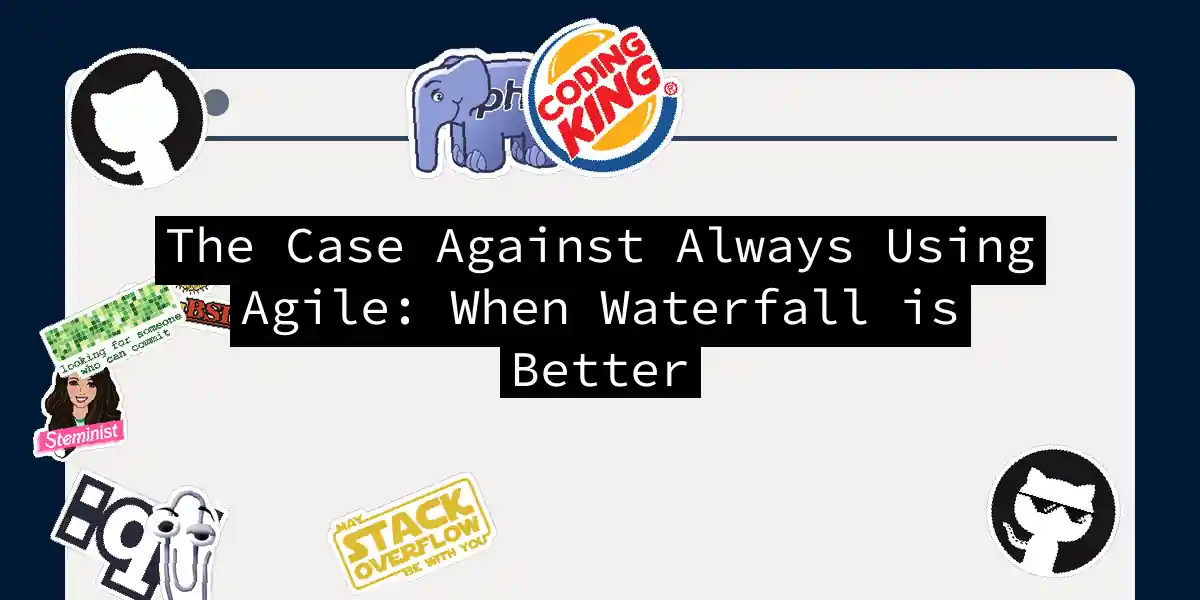Introduction to Agile and Waterfall
In the world of software development, two methodologies have dominated the landscape for years: Agile and Waterfall. Agile, with its iterative and flexible approach, has become the darling of many developers and project managers. However, this doesn’t mean it’s always the best choice. In fact, there are scenarios where Waterfall, with its linear and structured approach, is not only more suitable but also more effective.
Agile: The Flexible Favorite
Agile is built around the idea of continuous improvement and adaptation. It emphasizes collaboration, customer feedback, and the ability to pivot quickly in response to changing requirements. Agile projects are typically divided into short sprints, allowing for rapid development and testing cycles. This approach is ideal for projects with evolving requirements or those operating in dynamic environments.
Waterfall: The Structured Traditionalist
Waterfall, on the other hand, follows a sequential and linear process. Each phase must be completed before moving on to the next, which includes requirements gathering, design, implementation, testing, and maintenance. This methodology is well-suited for projects with well-defined requirements and strict deadlines. It provides a clear roadmap and predictability, making it easier to manage resources and timelines.
When Waterfall Trumps Agile
While Agile has become the go-to for many projects, there are specific scenarios where Waterfall is the better choice.
1. Projects with Fixed Requirements
In projects where requirements are well-defined and unlikely to change, Waterfall offers a clear advantage. It ensures that each phase is thoroughly completed before moving on, reducing the risk of rework and ensuring that all stakeholders are aligned with the project’s objectives.
2. Regulatory Compliance
Industries with strict regulatory requirements, such as healthcare or finance, often benefit from Waterfall’s structured approach. This methodology ensures that all necessary documentation and compliance checks are in place before proceeding to the next phase, reducing the risk of non-compliance.
3. Large-Scale Infrastructure Projects
For large-scale infrastructure projects, such as construction or manufacturing, Waterfall is often preferred. These projects typically involve sequential phases that cannot be started until the previous one is completed. Waterfall provides a clear timeline and resource allocation plan, which is crucial for managing complex dependencies.
4. Projects with Limited Stakeholder Involvement
In cases where stakeholders are not actively involved or prefer a hands-off approach, Waterfall can be more effective. It allows for a clear plan to be laid out at the beginning, with less need for ongoing feedback and adjustments.
The Challenges of Agile
While Agile offers flexibility and rapid iteration, it also comes with its own set of challenges.
1. Lack of Clear End Goals
Agile’s iterative nature can sometimes lead to a lack of clear end goals. Without a well-defined scope, projects can suffer from scope creep, where requirements continuously evolve, leading to extended timelines and increased costs.
2. Overemphasis on Speed
The focus on rapid delivery in Agile can sometimes lead to a rush in development, potentially compromising quality. Without thorough testing and validation, bugs and issues might slip through, affecting the overall quality of the product.
3. High Stakeholder Involvement
Agile requires active stakeholder involvement, which can be challenging if stakeholders are not available or engaged. Without their input, projects may not align with their needs, leading to dissatisfaction upon delivery.
Combining the Best of Both Worlds
In many cases, a hybrid approach that combines elements of both Agile and Waterfall can offer the best of both worlds. This allows for the flexibility of Agile while maintaining the structure and predictability of Waterfall.
Hybrid Approach Example
Imagine a project where the initial requirements are well-defined but there’s a possibility of changes during development. A hybrid approach could involve using Waterfall for the initial phases (requirements gathering and design) and then switching to Agile for implementation and testing. This way, you benefit from the structured planning of Waterfall while still allowing for flexibility and adaptation during the development phase.
Conclusion
While Agile has become the preferred methodology for many, it’s not a one-size-fits-all solution. Waterfall, with its structured approach, offers significant advantages in certain scenarios. By understanding the strengths and weaknesses of each methodology, developers and project managers can make informed decisions about which approach best suits their project needs. Ultimately, the key to success lies in flexibility—being willing to adapt and combine methodologies to achieve the best possible outcomes.
In the end, it’s not about which methodology is better; it’s about choosing the right tool for the job. And sometimes, that tool might just be Waterfall.
